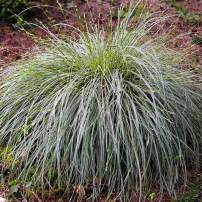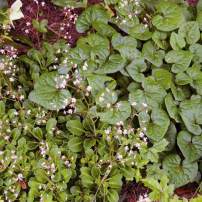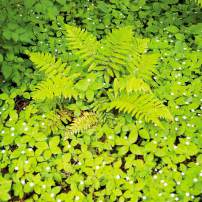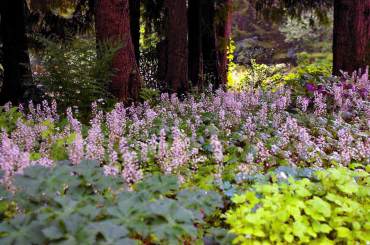
Ah, gorgeous trees and the shelter and shade they provide! Many local residents are blessed with towering conifers like Western red cedars or the fall colors of maples and other deciduous trees on their properties.
Despite all their advantages, trees can create a love-hate relationship, as the area underneath is sometimes a challenging spot to garden. Greedy roots slurp up water and nutrients widely from under the canopy and outcompete many plants that would otherwise enjoy the shady cover. Difficult, dry garden conditions can also be caused by overhangs, walls and buildings. The solution lies in understanding what has caused the situation and learning about plants that have evolved and adapted to such circumstances in nature.
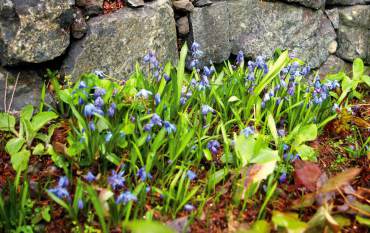
Shades of Shade
Not all shade is created equal. Full shade, dappled shade, part shade, bright shade — what does it all mean? Full shade describes an area that receives no direct sunlight whatsoever, at any time of the day. On plant tags, the symbol for full shade is a solid circle. Full shade can be bright shade — bright shade simply differentiates between full-shade areas that have more ambient light as compared with dense shade, which tends to be darker during daylight hours. Dense shade is often caused by imposing structures or large stands of conifers.
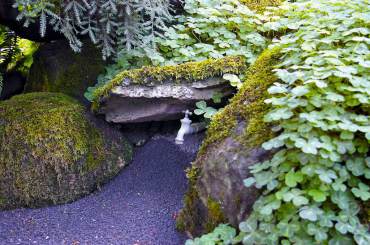
Dappled shade occurs when a break in the tree canopy or open grid patio cover allows spots of direct sun to fall on plants underneath. Dappled shade is a type of part shade — which simply describes an area that receives direct sun, the quantity and intensity of which changes during the day and from season to season. Plant tags for part-sun plants will have a circle with one side dark and one side light.
Generally speaking, part-shade locations that receive an hour or more of sun in the morning and are fully shaded in the afternoon are more forgiving on plants than part-shade areas that are shaded until noon but exposed to direct sun later in the day. Afternoon shade is often preferred by part-shade loving plants, as morning sunshine is usually less intense. Afternoon sun, especially in the summer months, is hot and plants that prefer full shade will certainly burn in these spots. A plant that likes part shade will require more water when it receives afternoon sun than it would with only morning sun.
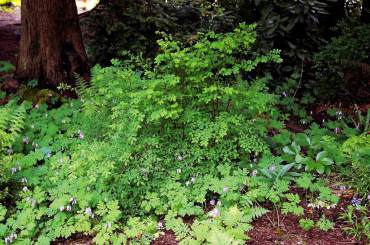
Morning shade with afternoon sun is a challenging garden position that requires a plant that likes at least part shade, or even full sun, especially if the site also experiences extra heat that radiates off concrete paving or walls. These situations are usually best for a plant whose tag includes both a part sun and a full sun symbol.
Shade Trees
The shade of evergreens is different from the shade cast by trees that lose their leaves. Evergreens block light and to a degree, rain, all year round. Deciduous trees block light and rain mainly during the growing season. For deciduous trees like maples and birch, under-plantings that are actively growing when the tree is dormant are good companions. When a beech tree loses its leaves, for instance, plants underneath are treated to a good dose of seasonal rain and some sunshine. The beech will also take up less water from the roots when dormant. Daffodils, snow drops and other bulbs underneath a deciduous tree will break ground and bloom before the tree has a complete canopy of new leaves. As the beech leaves fill out, the roots aggressively take up nutrients and water while the bulbs are entering dormancy, having absorbed their yearly quota of energy from the sun and soil.
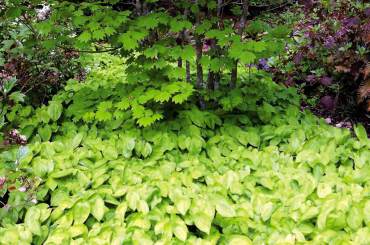
Knowing your particular tree is important to successfully gardening underneath. Some trees are shallowly rooted and resent digging underneath, like magnolias, which have fleshy, easily damaged roots. Some trees like drought at particular times during the season, and for these, additional watering can encourage disease.
For trees like oaks that resent summer watering, the best under-plantings are bulbs and other plants that go dormant in the summer. For trees that tolerate summer water, like birches and Japanese snowbell, there are more plant options. Western hemlocks may even benefit from the judicious use of a drip system in summer, as they dislike drought. Using a drip system to supplement the water needs of shade-loving under-plantings can give them a toehold to get established and thrive.
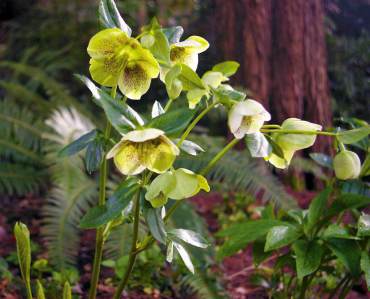
When working under existing trees, take care to protect the bark and roots. If you do install drip irrigation, trench out a distance from the canopy. It is better to tunnel under large roots than to cut through them. Even when digging in new plants, do so during the dormant season and locate them in spots where the soil is relatively loose and root-free.
Hitting a Wall
For some reason, the best-known plants are those that thrive in sun: roses, dahlias, mums, sunflowers, irises. When thinking about plants that thrive in the shade, people seem to draw a blank. Ferns seem to come to mind, though they are not always the best choice, as they usually require loose, regularly moist soil, while the ground under trees is often fibrous and dry. They can be appropriate, however, to shady situations caused by structures if the soil can be amended with compost and irrigated.
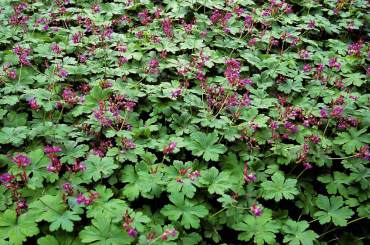
Eaves, walls and buildings can create not only dense shade, but year-round drought by blocking rain. Even in our rainiest seasons, the area under the eaves can be bone-dry. For plants grown in these sites, occasional irrigation may even be necessary in the winter.
When considering how to deal with the conditions created by buildings, ask whether the area is visible or not. If the area is not in plain sight, or is too narrow, plants may not be the answer. A low-maintenance option is to extend paving or mulch with bark, gravel or decorative rock in these sites.
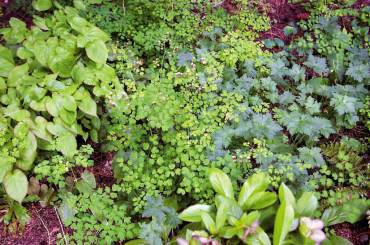
Some dryness along the base of structures, especially ones of wood construction, is desirable — never use sprinkler heads to irrigate along buildings or fences because the regular spray of water could cause rot. If irrigation is logical for the area, use drip lines, locating emitters a foot or more out from base of the structure.
If the ground slopes toward a structure, grade to redirect water away from the foundation. For extremely narrow locations along fences or buildings, using art (or hanging plants) on the walls with mulched ground underneath may do the trick. Sometimes slim, vertical-shaped containers planted with shade lovers and irrigated with individual drip emitters can turn a trouble spot into a showoff shady nook.
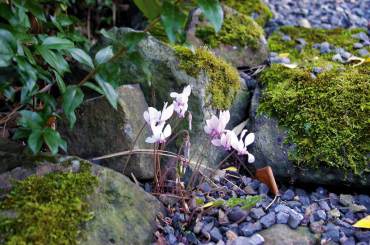
Natives and Other Appropriate Plants
When creating a list of plant options for dry shade, look for plants that are adapted to growing under trees or large shrubs in the wild, with special attention to native plants. Sword fern, deciduous huckleberry and wild ginger are a few shade-tolerant natives. Some of the natives are summer dormant — meaning they grow and bloom when rainfall is available, then store water in fleshy roots or bulbs to ride out summer drought. For nonnative selections, search for hardy plants from other regions of the world with dry summers such as those in West Sound. The Mediterranean, for instance, hosts drought-tolerant plants, like Corsican hellebore, which do well here. Looking at a plant’s origin will give clues to its preferred habitat.
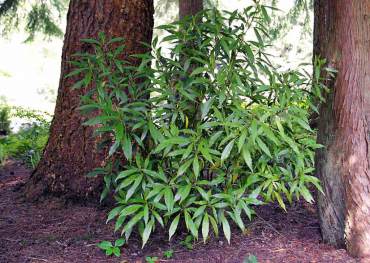
A word on drought tolerance: Just because a plant can survive without regular water does not mean it will look its best or will flower well. Even the toughest plants look and perform better with regular irrigation. All plants need regular summer water their first two years or so to become well established.
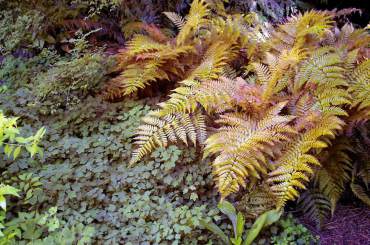
Mulching will help naturally dry areas retain moisture and can provide extra nutrients, but don’t apply mulch against the trunk and base of plants, as they will rot. Another tactic to ensure your shady plants get water and nourishing elements is to weed judiciously.
Plants that form low-growing mats are pleasing options for shade. Often times such shallowly rooted plants complement trees and shrubs that are more deeply rooted. Sedum oreganum is an easy native groundcover for part shade that slowly spreads to form large patches. Don’t forget grass-like plants — Hakone grass, some sedges and dwarf mondo grass like shade. The rounded forms of grasses can be a shapely counterpoint to woodland plants.




